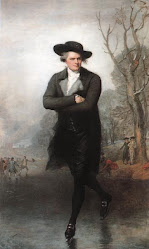Portrait of Edward Parker by Gilbert Stuart
England c 1787

from Lawrence Park:
Edward Parker
1730-1794
Of Browsholme, County York, England. He was a student at St. John’s College, Cambridge; Lord of the Manor at Ingleton; bowbearer of the Forest of Bowland. He married Barbara (d. 1873), daughter of Sir William Fleming, third Baronet of Rydal, County Westmoreland, by whom he had one son who only survived him three years.********
The gentleman portrayed here is of interest not only because he is the spitting image of Washington (lack of teeth, or similar dentures?), but primarily because he is associated with a magnficent ancestral estate ~the ultimate symbol of weath, tradition, and class in old England~ Browsholme Hall, (pronounced 'Brewsom'), built in
1507 in Lancashire, in the North West of England. Edward was a ‘relatively’ recent scion from the Parker family, tracing its origins to the 1300s, when they gained the title of 'park-keeper' to John of Gaunt, 1st Duke of Lancaster, Duke of Aquitaine (1340 –1399).
Edward Parker’s interest in commissioning Stuart to do his portrait stemmed surely from a wish to add his accurate likeness to the many ancestral portraits already adorning the silk-covered walls of his historic home. The Parker family has lived in this historic house since it was built, and as is typical of these huge, old, magnficent edifices requiring large sums of money for upkeep, the house was opened to the public in 1957, and today the estate’s architecture, fine art collections and furnishings, extensive landscaped gardens and lake, are advertised as an ideal location for film, TV and advertising; ‘an excellent backdrop for a variety of periods.’ “The present day owners Robert and Amanda Parker invite guests into the family home for small conferences, corporate hospitality, musical events, craft fairs and open days throughout the year.... and continue the work of administering and restoring the estate.” [http://www.browsholme.co.uk/]
Unfortunately it seems the family did not have the means to keep Edward’s portrait, for according to Park “The picture was purchased from the family by M. Knoedler & Co., New York, and sold in 1923 to Albert R. Jones, Esq. of Kansas City, Missouri.”
~

Lovely day, lovely house isn't it?
If you are a reader unversed in old English traditions (like me), you might ask what is a ‘bow-bearer of the Forest of Bowland’? from Wiki : The name Bowland of ‘Forest of Bowland’ has nothing to do with archery or with mediaeval cattle farms or dairies (Old Norse, buu-, cow), but derives from the Old Norse boga-/bogi-, meaning a “bend in a river”. It is a tenth-century coinage used to describe the topography of the Hodder basin, with its characteristic meandering river and streams.
map image
[courtesy http://en.wikipedia.org/wiki/Forest_of_Bowland]
Bowbearers of the Forest of Bowland have been appointed since the twelfth century. A Bowbearer was originally a noble who acted as ceremonial attendant to the Lord of Bowland, latterly the King, by bearing (carrying) his hunting bow, but over the centuries the Bowbearer's role underwent many changes. At an early date, the Bowbearer was a “forester in fee” who was the official in overall charge of the Forest ('a royal hunting ground'), normally paying rent for the position and having particular privileges such as cablish (the right to take dead or wind blown wood from the Forest). He was a paid official responsible to the King
. [http://apps.buckscc.gov.uk/eforms/medieval_life/pdfs/Forest_Officials.pdf]
Wikipedia states
[http://en.wikipedia.org/wiki/Forest_of_Bowland]: "as the last remnants of the ancient forest vanished, the office of Bowbearer was reduced to little more than an honorific. The Parker family of Browsholme Hall today claim to be "hereditary Bowbearers of Bowland" but this claim cannot be supported by the historical evidence. While the Parkers certainly served as Bowbearers over a number of generations up until 1858, they were always subject to grants made by the Lord of Bowland and hold no hereditary right.”

The Arms of the Parkers of Browsholme Hall
"Unmoved by either wave or wind"
"Keepers of the deer in the Royal Forest of Bowland"
more on
Browsholme Hall
In 1975 when the current owner, Robert Parker inherited the Hall from a distant cousin, the gardens where very overgrown, the front lawn was grazed by sheep and the ponds and rockeries colonised by trees. Yet underneath lay a landscape and garden that had continually changed in the hands of generations of the family since the house was built in 1507. After the 17thC, the grounds have been managed in the style of Capability Brown perhaps reflecting the difficulty of maintaining a garden in high rainfall (80 inches per annum), 600ft above sea level and the unforgiving bolder clay on which is situated.
With only a single gardener the garden is maintained as time and nature allows: it is a slow and patient process. Many projects take years to come to fruition, but this year they hope to restore and enlarge the ornamental pond next to the ‘box’ garden.
The Yew Walk which was planted over 300 years ago as a hedge now almost forms a tunnel and a sheltered path even during windy weather.
The Chestnut Avenue by comparison is barely 100 years old, but the white ‘candles’ make a superb display in May, a prelude to a crop of conkers later in the year.
The Lake, originally created about 1740 now extends to 3 acres and was one of the first restoration projects undertaken by the family in the 1970s and is stocked with trout. There is a pleasant walk around the lake.The Front Lodge built in the early 17thC with the Arch from Ingleton Hall is the best place to admire the magnificent setting of Browsholme.
[http://www.visitlancashire.com/site/things-to-do/search/browsholme-hall-p17787]
~
~







 map image
map image







